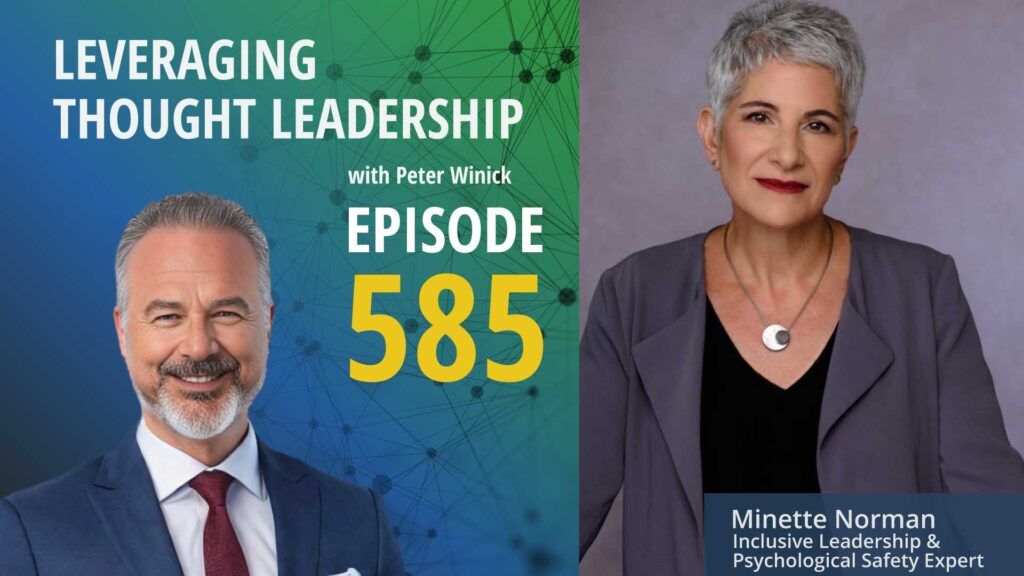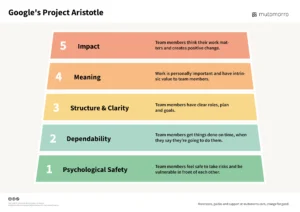A Hybrid Model That Blends Capability Building with Business Outcomes This episode explores how to…
The Power of Psychological Safety | Minette Norman

Practical Steps to Foster Inclusivity and Safety in Your Organization
A conversation with Minette Norman about her journey from tech to leadership and helping others become leaders that bring out the best versions of their teams through psychological safety and inclusion.
In this episode of the Thought Leadership Leverage podcast, host Peter Winick chats with Minette Norman, an author, keynote speaker, and leadership consultant with decades of experience leading global technical teams in the software industry.
Minette shares her journey from a stellar tech career to becoming an influential voice in inclusive leadership, psychological safety, and collaborative teams. Despite her success in tech, she realized many leaders were ill-prepared for their roles. As she advanced, the lack of proper leadership training became evident, and she often found herself and others navigating leadership by trial and error. When faced with a manager who didn’t appreciate her contributions, she chose to leave and focus on helping others become better leaders through her books, speaking engagements, and consulting.
Minette emphasizes the need for better leadership training and creating pathways for individual contributors to advance without necessarily moving into leadership roles. She discusses the importance of learning from poor leadership examples and using those experiences as lessons on what not to do.
Minette’s consulting work often begins with addressing issues of inclusivity within companies. She recalls working with a company where women felt they lacked opportunities for advancement and were often relegated to note-taking roles in meetings. By promoting inclusive meeting practices, she helped shift the company culture.
Her approach to consulting varies but always centers around inclusion, psychological safety, and creating environments where diverse teams can thrive. She notes that while psychological safety is now a buzzword, understanding its importance isn’t enough. There’s a need for practical guidance, which led her and Karolin Helbig to write “The Psychological Safety Playbook,” providing actionable steps to foster safe spaces at work.
Minette’s latest book, “The Boldly Inclusive Leader,” serves as both a resource and a calling card, drawing new clients who want to bring her expertise into their organizations.
Three Key Takeaways:
Inclusive Leadership is Crucial: Minette Norman emphasizes the importance of fostering inclusive leadership and psychological safety in the workplace. Creating an environment where diverse voices are heard and valued is essential for team success and employee well-being.
Practical Guidance for Psychological Safety: While the concept of psychological safety is widely recognized, Minette and her co-author Karolin Helbig identified a gap in practical guidance. Their book, “The Psychological Safety Playbook,” provides actionable steps for leaders to create safe spaces where employees can speak up and contribute fully.
Learning from Poor Leadership: Experiences with poor leaders can be valuable lessons. By observing and understanding what ineffective leadership looks like, individuals can avoid those pitfalls and strive to become better leaders themselves.
Transcript
Peter Winick And welcome, welcome, welcome. This is Peter Winick. I’m the founder and CEO at Thought Leadership Leverage. And you’re joining us on the podcast, which is leveraging thought leadership. Today, my guest is Minette Norman. She’s an author, a speaker, and a leadership consultant who previously spent decades leading global technical teams in the software industry. She has extensive experience leading internationally distributed teams and believes that when groups embrace diversity in all its forms, breakthroughs emerge, and innovations accelerate. She’s a keynote speaker on inclusive leadership, psychological safety, collaborative teams, and empathy, and she’s been named as one of the most influential women in the Bay area. And she is the author of the boldly Inclusive Leader and the coauthor of The Psychological Safety Playbook. So welcome aboard today. How are you a minute?
Minette Norman I’m good. It’s nice to be here with you, Peter.
Peter Winick Yeah. So how did how did all this happen? Because you had a stellar career on the tech side. And now you’ve got the books and the speaking and all those other things going on. How did I would. I wouldn’t know if I would call it a detour, but, how did how did we get to where we are today?
Minette Norman It’s been a journey, I guess. I always call it a journey because it’s taken lots of turns and twists and yeah, I will say that the short version of it is this is that I was in tech for 30 years. 20 of those years I was in leadership positions. And sort of the more I rose in the ranks, the bigger responsibility I had, the more I realized as if we are just so badly prepared to be leaders. You know, usually we’re good at what we do. Like I started out as a technical writer. I was really good at that, and I got promoted, and then I just kept taking on bigger and bigger jobs, and I felt we’re all just figuring this out by the seat of our pants. And unfortunately, I didn’t have a lot of great role models for leadership. I had a lot of negative role models, and I was trying to navigate and figure out, how can we lead this, you know, these very diverse and complicated, complex human beings that we all are. And how can we lead in a way that is going to bring out the best in everyone? And I felt honestly, and a lot of the time I was being held back because my voice wasn’t welcome, or if I spoke up, I was talked over or ignored or dismissed. And yet there I was leading. I mean, at one point I had like a thousand people on my org chart, and I was very global team, really trying to hear all the voices, hear diverse perspectives, do better, be more inclusive, be more innovative, all the things business leaders care about. And ultimately, what led me to the detour or the new twist in the road is that I got a new manager who didn’t really appreciate me, and I had the choice of staying and working for a manager who is not treating me well, and who doesn’t appreciate what I can bring to the table, or I can leave. And so in 2019, I left and I decided I want to help people do better in leadership, which led me to write books and do speaking and consulting.
Peter Winick So two things come to mind is you’re unpacking that. One is early in our careers, we’re recognized for more of our technical or specific or role. You know, if you’re a designer, it’s let me see the cool design. If you’re a programmer, let me check out the code. Whatever the thing is that you’re hired to do, that’s how you shine. And then all of a sudden you hit this place where it says, okay, well, now let me let you in on a little secret. You’re only going to get so far unless you learn how to lead and manage, etc. and most people haven’t been trained in those pieces, right? They’ve been a coder gets code right. A designer understands all the tools that they need to use to design well. So there’s a little bit of a whoa, nobody told me that. So respond to that. And then I’ve got another thought I’m going to you.
Minette Norman Yes, exactly. That is exactly it. And all too often we are really good at that thing. We’re good at whether it’s coding or design or writing or testing. And then suddenly we’re thrown into this world of human beings and the complexity of managing human beings. And many people are not suited to it, honestly, but we’re forced into that thinking that’s the only way to advance. So I already think that’s the problem. Like, why not have a great path or keep advancing as an individual contributor if that’s your calling? And if you do have that calling that you want to be a leader because you care about people and you care about bringing out the best in them, then let us get better training. Let us get better tools. Yeah. And let us pay attention to leadership skills in a way that we I, I think it’s often just lip service. We go to 1 or 2 trainings. And so I think that’s where we have to treat this as truly a profession. Yeah. And you know, be much more, much more seriously than we tend to.
Peter Winick Exactly. The other thing that you said that I, scribble down some notes on more was, well, the only thing I had was negative role models. And I would argue a little bit that at least for me, and I don’t know how many others, it holds true. Some of the things that I’ve learned, that’s the lessons that still stick today around leadership were because I saw things in the negative. Right. So there’s you know, we always think a role model has to be positive. Not that you want a negative mentor per say, but you can see things and go, wow, that person might be a great fill in the blank, but their crap is leading look good. The way they treat people, the way they talk to people, the way they, you know, foster, there’s no trust, whatever it is. So what is it that you might have learned from some of those, quote, negative role models that still stuck?
Minette Norman I agree with you that these are sometimes our best teachers, and I think in many ways they were, because I was really responding to, for example, a leader who would get up and say, you know, ask me questions, ask me anything, and then they would embarrass or humiliate someone who asks a challenging question I want to. 180 degrees from that. I want to be truly open to those hard questions and be willing to say, oh, I wasn’t quite prepared for that one. I don’t have a great answer or let me think about that. Can you give me a moment instead of having this terrible knee jerk reaction? That’s one example. Another was I remember one time a leader said to me, this is this is funny. He was trying to give me coaching. And he said, you know, one of the areas that you need to develop in is you need to stick to your guns and not change your mind. And I said, you know, what do you mean by that? He’s like, well, you got some new information and you changed your mind. And I was like, okay, here’s another lesson for me. It’s a really big strength to change your mind in the face of new information, right? Like, it doesn’t mean that you’re weak. It means that. Oh, you took in something that you didn’t know before. And that has informed what you’re going to do next. Because maybe you were missing something important, that new information made you change course. But that is the right thing to do as opposed to resolute sticking to your guns, even if you’re wrong.
Peter Winick Well, I think what’s interesting about that is the speed at which change is happening. Information is changing even the technical things. Right? Folks that are chief marketing officers today probably did not get trained on how to use AI to write copy when they were learning how to do their craft 20 years ago because it didn’t exist. So this concept of not changing in the face of new information, I mean, that’s probably a definition of stupidity, right?
Minette Norman Exactly, exactly. But, you know, for him and I’ve seen this so often, Peter, is that, you know, this, I guess if you think about traditional models of leadership. Yes. The leader knew everything, right? The leader was resolute, the leader was unflinching, all of these things. And I think that, you know, that has to evolve too, because we can’t possibly know everything. And as you said, change is just so rapid. So it doesn’t mean that we’re constantly flip flopping. But I think it does mean that when something new and important comes in, that we’re willing to take a turn or a different direction.
Peter Winick And if you’re enjoying this episode of Leveraging Thought Leadership, please make sure to subscribe. If you’d like to help spread the word about our podcast, please leave a five-star review at ratethispodcast.com/ltl and share it with your friends. We’re available on Apple Podcasts and on all major listening apps as well as at thought leadership leverage.com/podcast.
Peter Winick So let’s segway into your business right. So you’ve written a couple books you’re speaking. Tell me about sort of your business models. Who do you serve, the types of problems that you solve for them and what that looks like. Because you went from the I would say the I wouldn’t say the comfort, but the. Illusion of stability, if you will, of the corporate world to the other side of, being out there on your own. So. Well, what is it that that looks like for you?
Minette Norman Yeah. And honestly, that was such a huge term for me because I. And in fact, I didn’t even think I would start my own business because I thought I am not entrepreneurial. Right? I’ve worked for a company for 30 plus years. So, it was it was a lot of learning, honestly. And I will tell you that what you to your question, who do I serve? When I did first when I first started my business in 2020, of course, right when the pandemic happened that no one had budget, but my first client towards the end of 2020 was a tech company, and I assumed that all of my clients would be tech companies because that was my background. That kind of made sense to me. That was who I was communicating with, saying, like, all my tech friends, you know, this is what I do. And so I started the prob the first problem I solved for a company, and this continues to be, is that someone reached out and said, look, we are a relatively we’re not a startup, but we’re growing. And the women here, this was their problem. The women here don’t feel that they have an equitable experience. They’re not they don’t have, you know, there are no women in leadership. They don’t feel that they have opportunities. That was what brought them to me. And then when I started talking to the executive staff about how the culture worked, they asked a very innocent question. But the innocent but to me is a very leading question. What are your meetings like? And when they started to describe their meetings and like, okay. And so now I’m understanding some of this, it’s always a woman who takes notes. It’s often that’s the only woman in the room. Right, right. So anyway, I started working with them on improving meetings, making meetings more inclusive, which will then expand to making the culture more inclusive. That was my first consulting engagement. Now what I do is much broader. I mean, I worked with not only tech companies, but I’ve worked with universities, I worked with a school district, I’ve worked with some government agencies. The problem is this the problem is leaders want to do the right thing. I mean, that’s who’s at least coming to me, right? These are people who have an appetite for change, who have an appetite for growth and development. They want to create an inclusive, and inclusive culture where everyone can contribute, where everyone can do their best work, but they’re not quite sure what that looks like. And so sometimes I will do a workshop on meetings. Sometimes we start with psychological safety because that is so foundational to an inclusive culture. Like if you don’t feel you can speak up, if you don’t feel you can ask a question, well, you’re not going to have a culture where everyone can contribute and thrive. So it we come in from different angles depending on what the organization is struggling with, but it’s all-around inclusion, psychological safety, creating a workplace where you can have diverse teams. But it’s not just the diversity, it’s the inclusion, it’s the belonging. That’s where everyone can fully participate. That’s the problem I’m helping people solve.
Peter Winick So stay there for a minute because. The essence or the concept, or the ideas that are the underpinnings of psychological safety are not necessarily new ideas, right? No. However. I don’t think you would have been able to give away psychological safety 10 or 12 years ago to most companies most of the time, because we just weren’t ready for it. Right. The culture used to be, you’re here eight hours a day, check your baggage at the door, and nobody cares if you’re, you know, your pickup truck didn’t start, your wife left you and your dog died, right? Like, you know, nobody cares. And that was the model, right? Like that. We many of us operated on there for a long, long time. And then it changed. Right? So now there are new norms around. What does it mean to create a psychologically safe organization? Why would we do it? Well, we do it because people would be more productive, more engaged, more likely to stay whatever. So stay there for a minute because how do you know when the market’s ready? Because I’ve seen thought leaders go to market with some brilliant stuff. But the world just wasn’t ready yet you know. Yeah.
Minette Norman Oh it’s so interesting. And I honestly feel like, you know, this this book that I co-wrote, the psychological Safety Playbook. I’ll tell you a little bit about how that came to be, because I think it answers your question. So I you know, I first heard the term psychological safety, probably around 20 1516 when I was in tech, I was actually doing some research for a keynote, and I found the Google study, that Project Aristotle, that became quite famous, where they found that psychological safety was the number one driver of successful teams. So that’s where I first heard it. And I found, Amy Edmondson research on psychological safety. She’s, of course, the most well known researcher. And her book came out The Fearless Organization. I think it was 2017. That was, I think, when people started hearing the term. I mean, I remember introducing it to the company where I was working, like people didn’t use it. But now, as you said, now it’s a buzz word. Actually, it’s in all the business literature. Everyone has heard the term there is, you know, Amy Edmonton’s book, there’s Tim Clarke’s book, The Four Stages of Psychological Safety. These are super well known. So people have and I also think, honestly, through the pandemic, through the George Floyd murder, all of the changes that happened, certainly in the U.S., but globally as well, where people are realizing we have got to treat our employees differently, we have to talk about things differently. So I think all of that set the stage. And what happened was that people now have said, okay, we need to they use it a lot, like we need to create a psychologically safe workplace or this is a safe space. They love to say, yeah, what? Chibok this is where I found the gap. I think this answers your question about why now and like how do you know the markets ready. The gap that I found in my coauthor, Caroline Helbig and I found is that now there’s a lot of research out there. People have read it all, they’ve read Amy Edmondson, they’ve read Tim Clark, they read a book. They know it’s important now what? 
Peter Winick Get the now what?
Minette Norman Because that’s where I’m going to go.
Peter Winick Yeah, yeah. That’s the other piece is the opportunity is if I’m a middle aged manager and I grew up in one time period, right where I was different, psychological safety was different. Whatever. And now you’ve changed the rules, right? Yes. And you haven’t. You know, sort of up my skills or retrained me. I could have the greatest Intel and say, oh, okay, I get this. I read that article or my boss talked to me about this. So I want to really create a great, psychologically safe environment. Well, if I’m not trained, you know, I could do some really stupid, harmful things or like, I might. I’m in. And you, you’re looking a little blue or sulky. Hey, Minette, why do you look depressed today? Like, probably not a good thing to say in a meeting, right? Like so what are these new boundaries? Where are they? What are. You know, and it’s we went through this with sexual harassment. We’re going through this with DNI. And anytime you’re changing the game, you know, people get scared and don’t know what to do. So how do I mean? I would assume that’s an opportunity for you and your business.
Minette Norman That’s what. Yeah. And that that is honestly why Carolyn Helbig and I wrote the book week. We actually because she’s a leadership consultant in Germany. I’m here in the U.S. we both care about psychological safety. We’re like, what’s the how to where’s the how to manual? We couldn’t find it. We took a class together. That’s where we met. The class was on running assessments based on Amy Edmondson work came out of the class going now what? Still. And we decided we’re going to have to write this book because no one has done it. So that was the opportunity we seized on. And what’s been so interesting is how much appetite there has been for this book that is, by design, like a manual, like a playbook, really modular, really short, really accessible. And it’s all how to information. And then that actually drives a lot of business. I do a lot of workshops, I do a lot of keynotes on psychological safety, either by itself or psychological safety as the foundation for inclusive cultures. And so that was that book. And then my second book, of course, that came out more recently, Build Inclusive Leader, which is all about being an inclusive leader. Both of those books have served, as you know, calling cards for my business, really. So people are like, oh, I want to get the author of that book, The Psychological Safety Playbook, or the boldly inclusive leader to come do some work with us. And, you know, I just had another I just put in a proposal for something for someone who reached out to me that I didn’t know had read one of the books. So that’s how it ties in. And I think that the opportunity I mean, it’s interesting what you said about the timing. The timing was right for the playbook. The timing is different on The Bold, the Inclusive leader, because there actually a lot of books out there now on inclusive leadership. And then the question is like, which one is the right one for me? You know, and it sort of depends on what you care about. Right.
Peter Winick Well, and that’s part of the issue is, you know, if you get to the party too early, the market’s not ready. If you get there, it’s flooded. Right. It’s hard to time the Goldilocks.
Minette Norman Exactly.
Peter Winick So as we start to read, what are the couple of things that you would advise you? Five how many years ago did you say you left your role? Five years.
Minette Norman About five years ago. Not quite five. Yeah.
Peter Winick Sitting on the other side of it now, what would you tell yourself? Your five-year younger self now that you you’ve learned over the last five years being out on your own?
Minette Norman Oh, I’ve learned so much, but I but some of the key things are there are lots of ups and downs, you know, I mean, it’s so not linear. There are moments where I feel like I have too much work, I have too many clients, I’m overloaded. And then there’s the troughs where it’s like, am I ever going to have more work, you know? So there’s a lot of that up and down. The other thing is that I think this was this would be a pep talk for myself five years ago is, you know, so much more than you think you do. You have learned so much over the day, and people will pay you for that expertise. They will engage you for that expertise and do not minimize the hands on work that you did leading teams for 20 years. That is invaluable. That’s honestly why people would hire me as opposed to someone else, because of the real world experience.
Peter Winick You’ve been in The Matrix. Well, this is great. I appreciate your time and I thank you for sharing your story with us. Thanks. Thanks so much, Minette.
Minette Norman Thank you Peter.
Peter Winick To learn more about Thought Leadership Leverage, please visit our website at ThoughtLeadershipLeverage.com. To reach me directly, feel free to email me at Peter at ThoughtLeadershipLeverage.com, and please subscribe to Leveraging Thought Leadership on iTunes or your favorite podcast app to get your weekly episode automatically.





